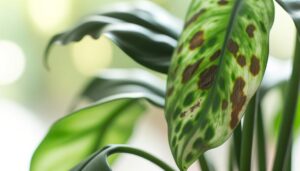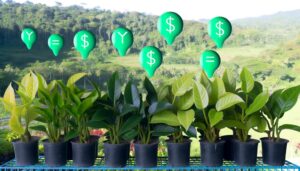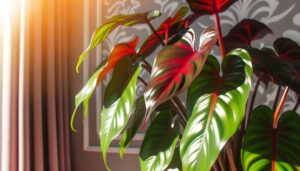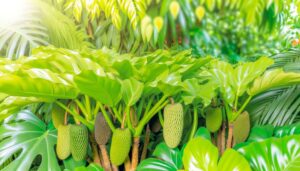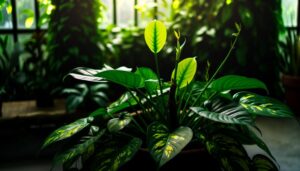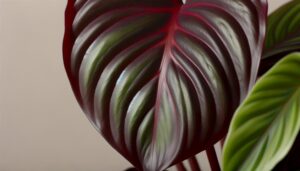Why Are My Philodendron Birkin’S New Leaves Rotting?
The decaying of new leaves on your Philodendron Birkin is often due to overwatering and poor drainage, which create anaerobic conditions and promote pathogenic growth. Inadequate light and insufficient air circulation can further exacerbate the issue, weakening the plant's natural defenses.
Well-draining soil and a consistent watering routine are essential for maintaining plant health. Humidity levels between 60-80% are ideal but should be managed to avoid excessive moisture.
Quick diagnosis and treatment of fungal and bacterial infections with appropriate fungicides are critical. For a thorough understanding of these factors and their management, explore further.
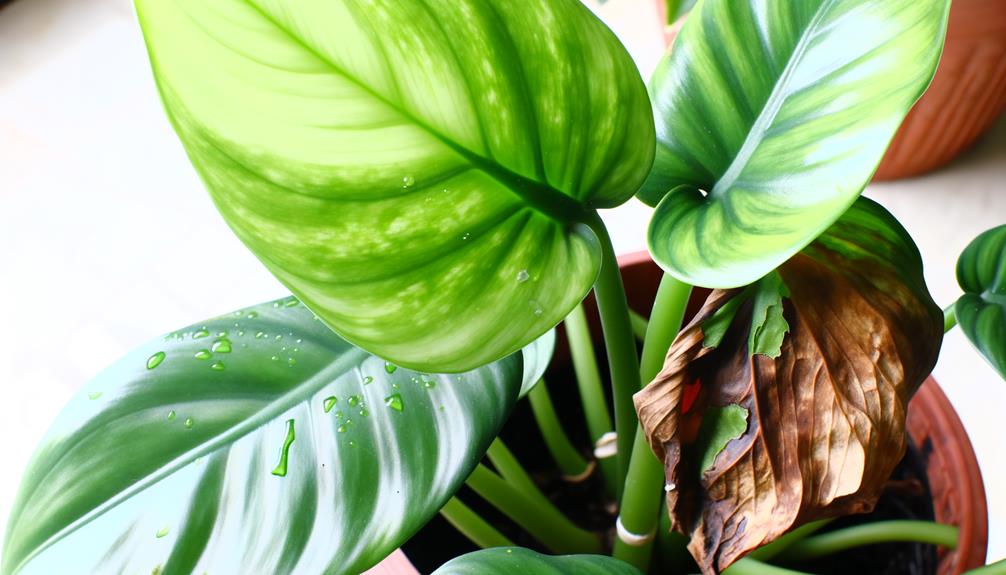
Key Takeaways
- Overwatering leads to anaerobic conditions, fostering root rot and leaf decay.
- Poor drainage causes waterlogged roots, contributing to rotting leaves.
- Insufficient light weakens the plant, slowing metabolism and increasing moisture retention.
- Fungal infections from pathogens like Phytophthora cause blackened, mushy areas on leaves.
- High humidity and poor air circulation increase the risk of fungal and bacterial infections.
Overwatering

Overwatering is a predominant cause of new leaf rot in Philodendron Birkin, resulting from excessive moisture in the soil that inhibits proper oxygen exchange to the roots. When soil remains overly saturated, it creates an anaerobic environment, fostering the growth of pathogenic fungi and bacteria. These microorganisms attack the vulnerable new leaves, leading to necrosis and rot.
Additionally, the lack of oxygen impairs root function, reducing the plant's ability to uptake essential nutrients and water efficiently. This physiological stress manifests in the form of yellowing, wilting, and eventual decay of new foliage.
Careful monitoring of watering frequency and ensuring the soil surface dries slightly between waterings can mitigate the risks associated with overwatering, thereby promoting healthier growth in Philodendron Birkin.
Poor Drainage
Poor drainage is an essential factor contributing to the rotting of new leaves in Philodendron Birkin. When the soil retains excess water or the pot lacks sufficient drainage holes, the plant's root system becomes waterlogged, leading to root rot and subsequent leaf decay.
Additionally, improper watering techniques exacerbate these issues, further impairing the plant's health and well-being.
Soil Retains Excess Water
Excessive water retention in the soil, often a result of inadequate drainage, can create an anaerobic environment that promotes the growth of harmful pathogens and leads to root rot in Philodendron Birkin plants.
This waterlogged condition deprives roots of essential oxygen, impeding their ability to function properly. Consequently, the roots become susceptible to fungal infections, such as Pythium and Phytophthora, which can cause the new leaves to rot.
The deteriorating roots fail to absorb nutrients effectively, leading to further health decline in the plant. Ensuring that the soil composition includes components like perlite or coarse sand can enhance drainage, thereby preventing water accumulation and reducing the risk of pathogenic invasion and subsequent leaf rot.
Pot Lacks Drainage Holes
A significant contributing factor to the waterlogged conditions that promote root rot in Philodendron Birkin is the absence of drainage holes in the pot, which prevents excess water from escaping and creates an environment conducive to anaerobic conditions.
Without proper drainage, water accumulates at the bottom of the pot, saturating the soil and depriving roots of essential oxygen. This leads to a hypoxic environment that fosters the growth of pathogenic fungi and bacteria, causing root rot.
The compromised roots then fail to supply adequate nutrients and water to the plant, resulting in the rotting of new leaves. Ensuring that pots have sufficient drainage holes is essential for maintaining the best soil aeration and preventing the detrimental effects of waterlogged conditions.
Improper Watering Techniques
Improper watering methods, particularly irregular watering schedules and overwatering, are primary factors that worsen poor drainage in Philodendron Birkin, leading to anoxic conditions detrimental to root health.
When the soil remains excessively saturated, oxygen availability decreases, impairing root respiration and promoting anaerobic conditions. This setting encourages the spread of harmful fungi and bacteria, resulting in root rot.
Consequently, the compromised root system fails to support new leaf growth, leading to the decay of emerging leaves.
To address this issue, it is crucial to adopt a consistent watering routine, allowing the top inch of soil to dry between waterings.
Additionally, using a well-draining soil mix enriched with perlite or bark can further prevent waterlogging, ensuring ideal root health and robust growth.
Insufficient Light

Insufficient light conditions can greatly impair the health of Philodendron Birkin, leading to issues such as the rotting of new leaves. Adequate light is essential for photosynthesis, the process by which plants produce the energy necessary for growth and cellular function.
In low light, the plant's metabolic activities slow down, weakening its overall structure and making it more susceptible to rot. The reduced energy production can result in poor leaf development and increased moisture retention, creating a conducive environment for rot.
To mitigate this, it is advisable to place the Philodendron Birkin in bright, indirect light. Using grow lights can also supplement natural light, ensuring the plant receives the necessary photoperiod to maintain its vigor and prevent leaf rot.
Fungal Infections
Fungal infections in Philodendron Birkin are commonly caused by pathogens like Phytophthora, Pythium, and Rhizoctonia. These infections manifest as blackened, mushy areas on leaves and stems, requiring quick diagnosis to contain spreading. Effective management strategies include the application of fungicides, maintaining proper watering practices, and ensuring sufficient air circulation.
These practices can help prevent the onset and spread of new leaf rot in Philodendron Birkin plants.
Common Fungal Culprits
Among the main fungal pathogens that can afflict Philodendron Birkin, *Pythium* and *Phytophthora* species are particularly infamous for causing root and stem rot, leading to the deterioration of new leaves. These oomycetes thrive in excessively moist conditions and can rapidly colonize plant tissues, disrupting nutrient and water uptake.
*Pythium* species often invade through root tips, causing them to become brown and mushy. Conversely, *Phytophthora* mainly attacks the stem base, resulting in blackened, water-soaked lesions. Both pathogens produce motile spores that can spread through contaminated water or soil.
Effective management requires maintaining proper drainage, avoiding overwatering, and employing fungicidal treatments. Understanding these troublemakers is pivotal for preventing the rot and preserving Philodendron Birkin's health.
Symptoms and Diagnosis
Recognizing the symptoms of fungal infections in Philodendron Birkin is paramount for timely and accurate diagnosis, ensuring effective management and recovery of the plant. Initial signs include water-soaked lesions on new leaves, which may progress to dark, mushy spots as the infection advances.
The affected areas often develop a yellow halo, indicating tissue decay. Moreover, fungal spores may manifest as a powdery or fuzzy growth on the leaf surface.
If left unchecked, these symptoms can lead to complete leaf necrosis and plant decline. Distinctive odors emanating from rotting foliage also signal a severe infection.
Accurate identification of these symptoms is essential for differentiating fungal infections from other potential issues such as bacterial infections or nutrient deficiencies.
Treatment and Prevention
Effective management of fungal infections in Philodendron Birkin necessitates a multifaceted approach encompassing both treatment and preventive measures. Treatment typically involves fungicidal applications, ensuring the plant's environment is not overly humid, and improving air circulation. Preventive measures include avoiding waterlogged soil, sterilizing tools before use, and monitoring for early signs of infection. Below is a table summarizing key treatments and preventive strategies:
| Treatment Method | Description | Preventive Measure |
|---|---|---|
| Fungicidal Application | Use of appropriate fungicides to treat infection | Avoid waterlogged soil |
| Environmental Control | Reduce humidity and increase air circulation | Sterilize tools before use |
| Monitoring and Pruning | Regularly check for signs and remove affected leaves | Monitor plant health and early symptoms |
Implementing these strategies can notably reduce the incidence of fungal infections.
Bacterial Infections
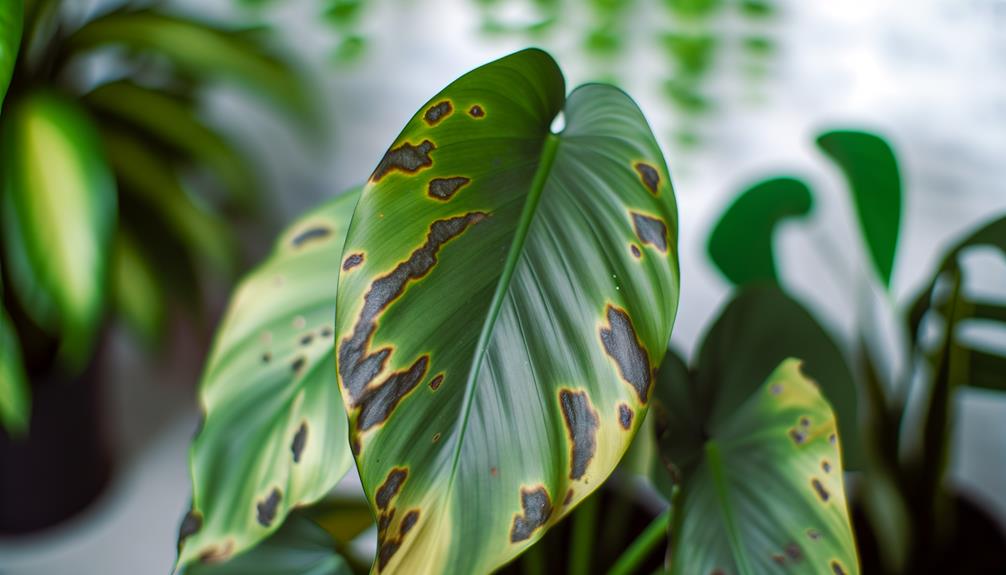
Bacterial infections, often caused by pathogens such as Erwinia carotovora, can lead to the rapid deterioration and rotting of new leaves in Philodendron Birkin plants. This bacterium thrives in warm, moist environments and infiltrates plant tissues through natural openings or wounds.
Symptoms of bacterial infection include:
- Soft, mushy leaves: Affected leaves become water-soaked and emit a foul odor.
- Blackened leaf veins: Discoloration spreads from veins to surrounding tissues.
- Wilting: Infected plants exhibit overall droopiness and loss of vigor.
Prompt identification and isolation of infected plants are essential to prevent the spread of bacteria. Implementing sterilization protocols for gardening tools and ensuring proper drainage can mitigate the risk of bacterial infections. Consistent monitoring and sanitation are vital to maintaining plant health.
Humidity Levels
Maintaining ideal humidity levels is essential for the health of Philodendron Birkin plants. Insufficient humidity can worsen issues related to leaf rot. Best humidity levels for this tropical plant range between 60-80%.
When humidity levels fall below this range, the plant experiences stress, reducing its natural defenses against pathogens. This stress can make the new leaves more susceptible to fungal and bacterial infections, leading to rot.
Conversely, excessively high humidity can also foster an environment conducive to mold and mildew proliferation, which can further exacerbate leaf rot. Employing a hygrometer to monitor humidity and using a humidifier or pebble tray to maintain appropriate levels can mitigate these risks and promote robust plant health.
Inadequate Air Circulation
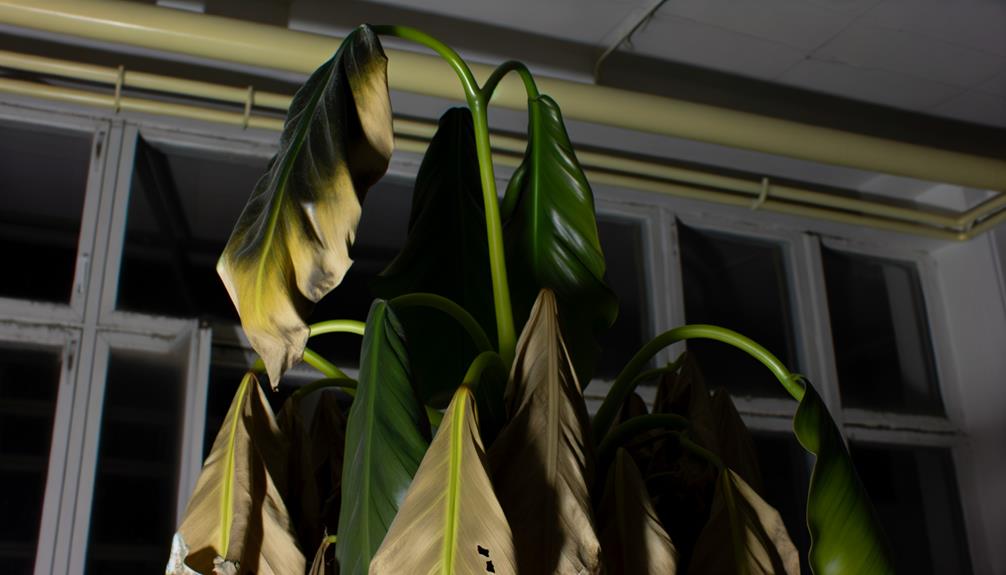
Inadequate air movement around Philodendron Birkin can significantly contribute to the development and spread of leaf rot by fostering an environment where moisture accumulates, promoting the growth of fungal and bacterial pathogens. Stagnant air can impede the natural evaporation of water from leaf surfaces, leading to consistently damp conditions that are optimal for pathogenic activity. This setting is harmful to the plant's health, causing the new leaves to decay.
To address this issue, consider the following strategies:
- Enhance airflow: Utilize fans or open windows to boost air circulation around the plant.
- Trim densely packed foliage: This enhances air flow and reduces pockets of humidity.
- Maintain appropriate spacing: Make sure plants are not overcrowded to allow for adequate air movement.
Proper air circulation is essential for preventing leaf rot in Philodendron Birkin.
Soil Quality
Ensuring ideal soil quality is necessary for the health of Philodendron Birkin, as it directly affects the plant's ability to absorb nutrients and manage moisture levels.
A well-draining soil mix, typically composed of peat, perlite, and orchid bark, is important to prevent waterlogging, which can lead to root rot and subsequent leaf decay. The presence of organic matter in the soil enhances nutrient retention while promoting aeration.
Soil pH should be slightly acidic to neutral, ranging between 5.5 and 7.0, to optimize nutrient uptake. Regularly monitoring the soil's moisture content is crucial; the top inch should dry out between waterings to prevent fungal growth.
Proper soil management is essential in maintaining the overall health of Philodendron Birkin.
Conclusion
To summarize, the Philodendron Birkin, a symbol of botanical elegance, ironically succumbs to ailments that result from the very care intended to nurture it. Factors such as overwatering, poor drainage, and insufficient light create an environment ripe for fungal and bacterial infections.
Additionally, imbalanced humidity levels, inadequate air circulation, and subpar soil quality further exacerbate leaf rot. Consequently, the plant's demise is paradoxically orchestrated by the excessive attentiveness of its caregiver, highlighting the fine line between nurturing and negligence.

